Visiting Armenia, Azerbaijan, Georgia
Learn about the physical role the Caucasus mountains have played in shaping the history of the region. Join a small group tour for mature and senior travellers couples and solo travellers to explore and understand the fascinating and intertwined history of Armenia, Georgia and Azerbaijan including the origins of Christianity. in amongst the mosques of Islam.
4 Oct 19 · 18 mins read
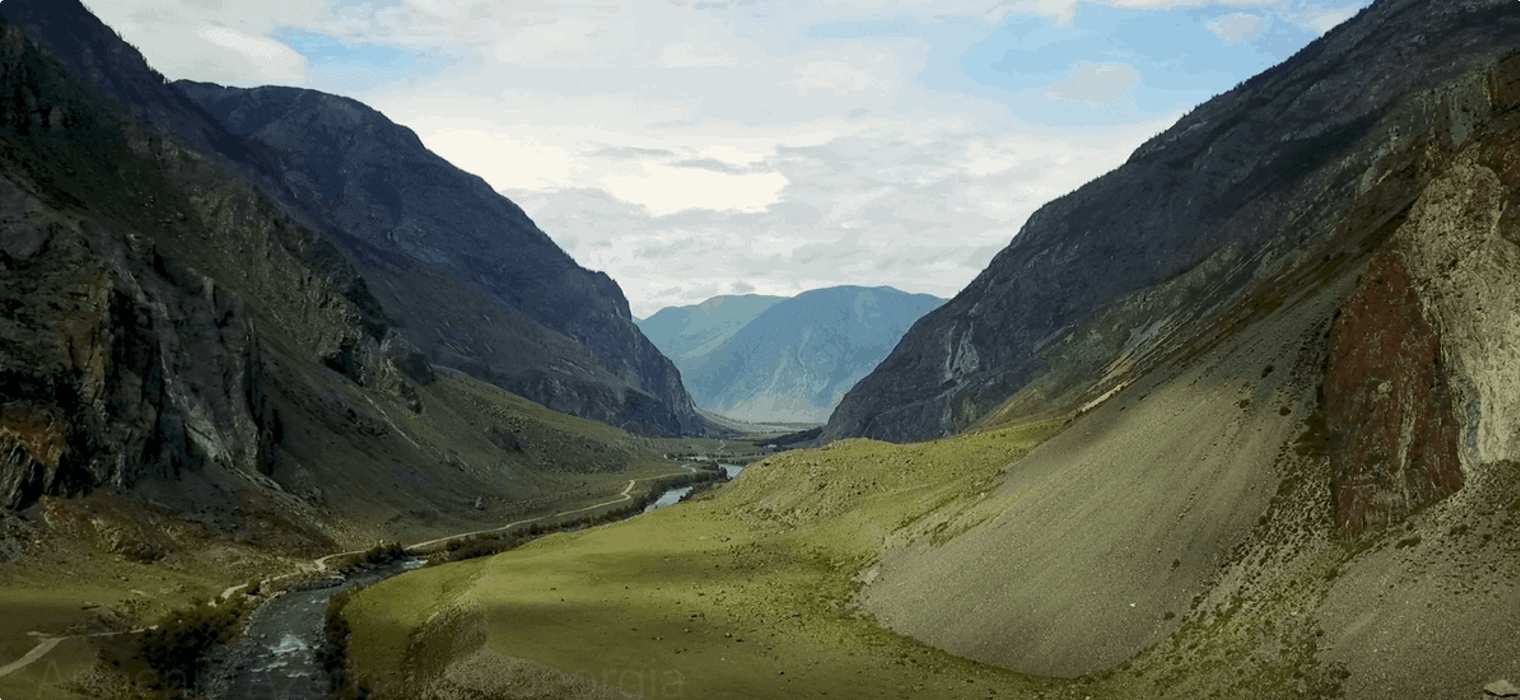
Visiting Armenia, Azerbaijan, Georgia: The South Caucasus
Visiting Armenia, Azerbaijan, and Georgia in one trip makes logistical sense as the countries sit next to each other south of the Caucasus Mountains but their deep, historical connections also make it imperative for travellers to visit all three to get a clearer picture of the region. In this article we will take a look at the region’s entwined histories and some of the must-see sites.

Armenia, Azerbaijan, and Georgia are often referred to as ‘the Caucasus region’. The Caucasus, or Caucasia, refers to both the mountain system and the region bounded by the Black Sea in the west and the Caspian Sea in the east. This mountain system includes the Greater Caucasus mountain range in the north – which serves as a natural barrier between Eastern Europe and Western Asia and includes Europe’s highest mountain, Mount Elbrus (height 5,642 metres or 18,510 ft) – and the Lesser Caucasus in the south.
The name Caucasus comes from Kaukasos, which was what the Ancient Greeks used to refer to the mountains. For centuries throughout history, the Caucasus was associated with myth of Prometheus. In Greek mythology, Prometheus was punished for stealing fire from the gods by being chained to the icy peaks of the Greater Caucasus chain. The land north of the Greater Caucasus (Ciscaucasia) is in Russian territory and includes Dagestan and Chechnya, while the south (South Caucasus or Transcaucasia) is occupied by the former Soviet territories and now independent republics of Armenia, Azerbaijan, and Georgia. It is this region, south of the mountain barrier, that we will examine.
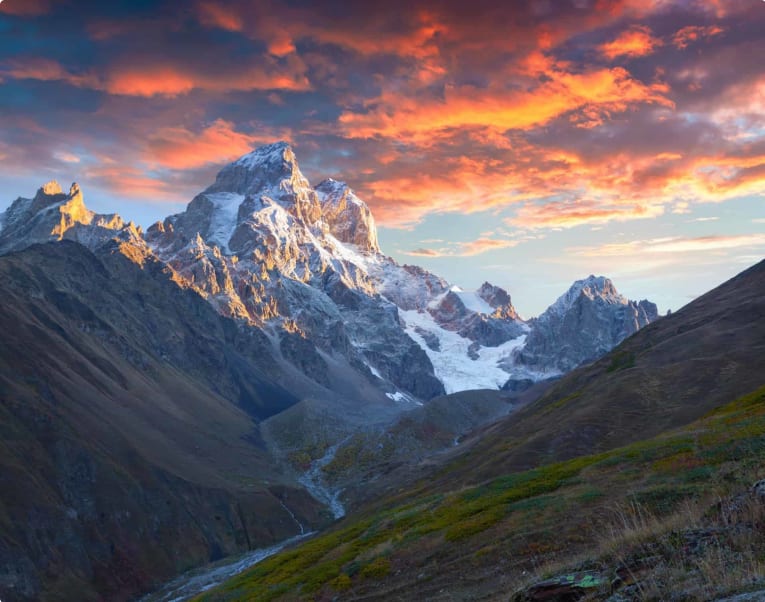
The mountainous landscape is one defining feature of the South Caucasus but the region is also home to lush wine-making plains, burnt, arid deserts, and stretches of subtropical coastline. For a small region that is home to around 15 million people, the South Caucasus is notable for its geographic, ethnic, cultural and linguistic diversity. In fact, in Arabic the Caucasus was often referred to as the ‘mountain of languages’ and in terms of linguistic diversity, the region is second only to Papua New Guinea (which is home to nearly 850 languages).
Kambiz Kamrani (2008) shares a map of the languages spoken in the Caucasus and says that one ‘can expect to find representative languages from the Kartvelian, Abkhaz-Adyghe, Lesgian, Nakh, Indo-European, Avar-Andi-Dido, Andi, Dido/Tsez, Lak-Dargwa, Turkic language families’. This long list gives some sense of the multitude of languages and dialects found in this region. For example the Kartvelian language family alone includes four languages: Georgian, Megrelian (Mingrelian), Svan and Laz (or Chan). These mix of languages, many of which are mutually unintelligble, tell a story about the complicated past of the Caucasus and the main nationalities contained within the region’s imagined boundaries.
To quote the Pulitzer Center, ‘[I]n this part of the world, geography is destiny’. The mountainous terrain of the Caucasus means that apart from political barriers, the nations here also need to contend with natural barriers that may have isolated some groups for millennia, allowing them to form their own culture and language. The Caucasus, bounded by two seas, has also seen numerous waves of human migration, adding to the diversity of the region. Population growth, wars and invasions have shaped the genealogy and societal structures here, and as a result the South Caucasus has multiple and converging identities.
In this article, we will give a brief overview of the region’s shared history and what travellers can expect to see in each of the three countries.
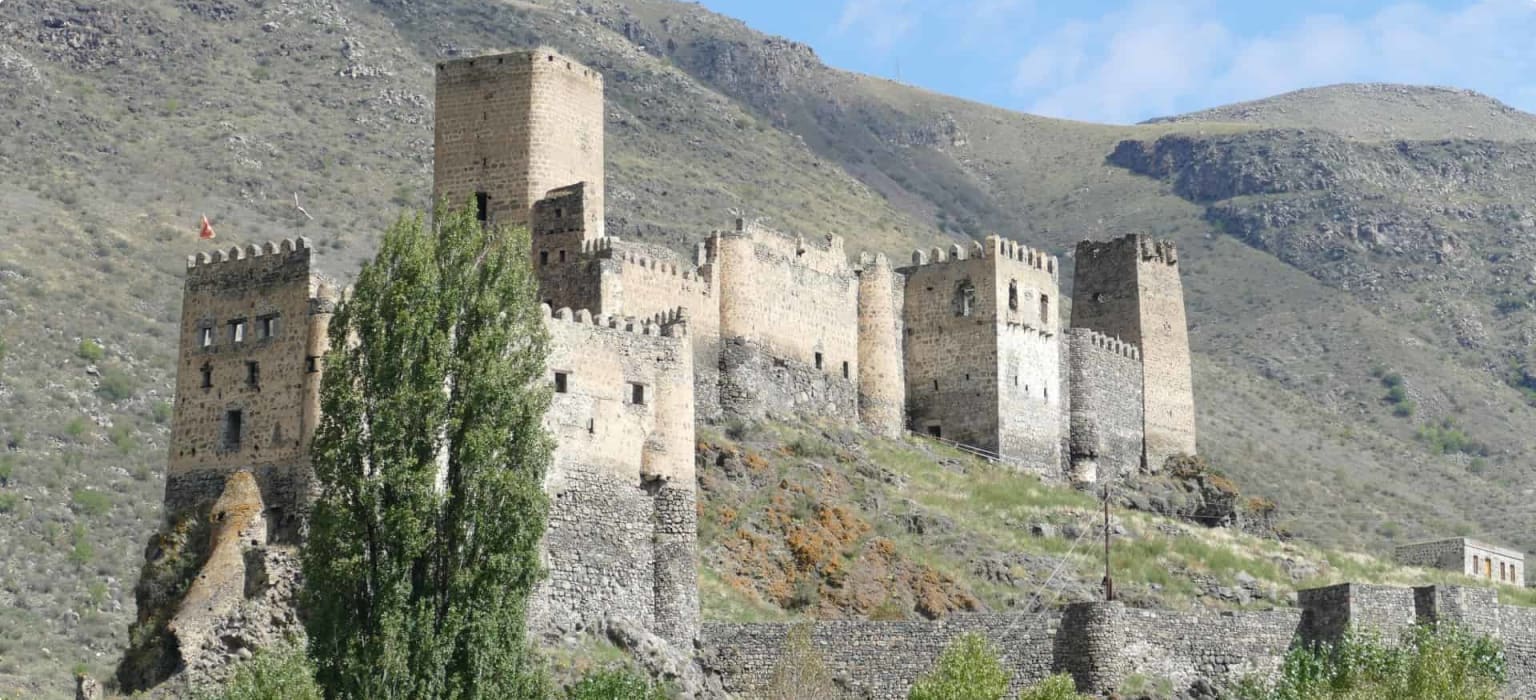
Armenia, Azerbaijan, and Georgia: A Shared History
Armenia, Azerbaijan, and Georgia have a long history. Some parts of this long history overlap as their borders were redrawn after every war or invasive siege, each country growing bigger, smaller, or encroaching on another’s territory. The prime geographical location, mild climate, and fertile lands of the South Caucasus led to invasions from every major power in the world throughout the centuries. The Greeks, Persians, Romans, Byzantines, Mongols, Ottomans, and the former Soviet Union have all left their mark in the region.
The Ancient Kingdom of Colchis covered what is now western Georgia and dates back to the Bronze Age. The Greeks established colonies in Colchis between the 8th and 6th centuries BC. The wealthy kingdom figures prominently in Greek mythology. It was said to be the home of Princess Medea, the site of war god Ares’s sacred grove, the land of the Amazons, and the destination of Jason and the Argonauts.
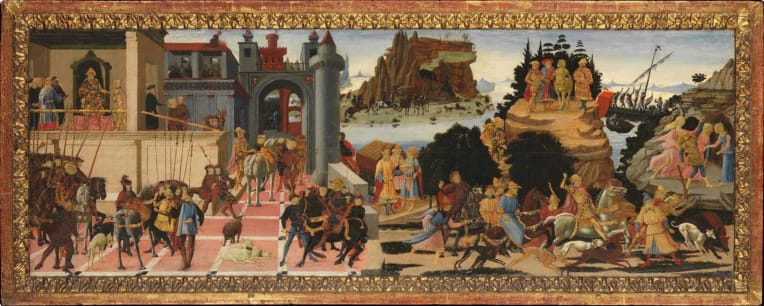
Modern Armenia is considerably smaller than ancient Armenia, which at the height of its power included parts of modern-day Iran, Turkey, and Iraq. (You can read more about ancient Armenia in this article.) In 8th Century BC, the Urartian King Argishti I founded the city of Erebuni, which today is Armenia’s capital, Yerevan. After the decline of the Kingdom of Urartu, the Caucasus was taken over by Cyrus the Great’s Achaemenian Empire, followed by Alexander the Great, the Roman Empire, and the Sasanid dynasty of Persia.
The great Arsacid King Tiridates III (or Trdat III) united Armenia and, perhaps in an effort to distance the nation from both Persian Zoroastrianism and Roman polytheism, declared Christianity as the state religion in 301 AD, making Armenia the first Christian state in the world. Georgia followed years later, while Azerbaijan (then known as Caucasian Albania) remained largely Zoroastrian until later conquests.
During the 10th century, one group of Turkish nomadic tribes led by a chief named Seljuq settled in Central Asia and later converted to the Sunni form of Islam. (The Seljuq and their influence are mentioned briefly in this article on Persian carpets.) The Seljuq Empire dominated the Caucasus region for the next two centuries, but were driven out of Georgia by King Davit Aghmashenebeli (David the Builder, 1089−1125) which marked the dawn of Georgia’s golden age.
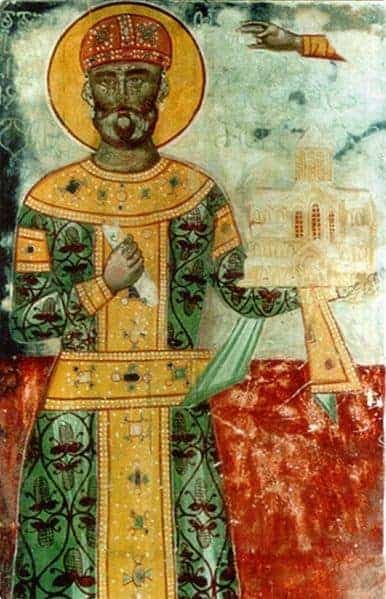
For the next two centuries, the Georgian kingdom became a strong regional power, developing its own art and literature and extending its cultural influence across the Caucasus. When David’s great-granddaughter Queen Tamar (1184−1213) ascended the throne as Georgia’s first female ruler, her kingdom controlled a vast territory that stretched from western Azerbaijan to eastern Turkey.
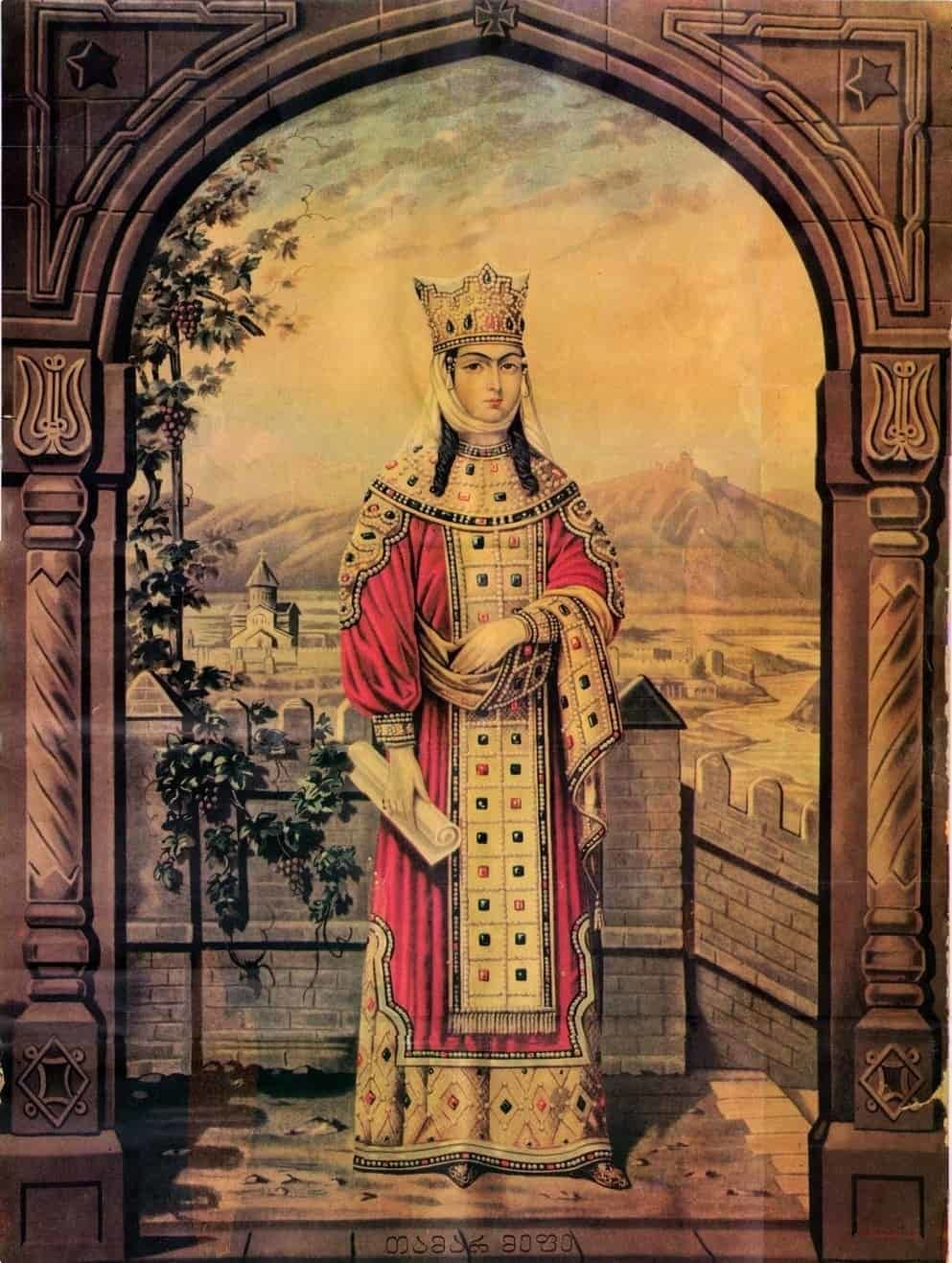
Georgia’s Golden Era ended with Tamar’s death as the invasions continued. Next to invade the region were the Mongols, who ruled the South Caucasus from the 12th century to the late 1330s, and the Turco-Mongol conqueror Timur, who led several invasions into the Caucasus until 1403.
Throughout the years marked by these foreign incursions, Shirvan in modern Azerbaijan was ruled by the Shirvanshahs (an ancient Persian title for Shirvan rulers) from a single family, the Yazidid dynasty, who broke free from the Persian Abbasid caliphate. They ruled Shirvan as vassals to Timur, but became autonomous, ruling from the 8th to around the 16th centuries. The state Baku (which today is Azerbaijan’s capital and largest city) grew to become a prosperous trade centre in the 15th century.
In 1501 Shirvan was conquered by Persia’s Safavid Dynasty. The Safavids converted the state from Sunni to Shia Islam. Shia Muslims remain the majority in Azerbaijan, which is home to the second highest Shia population percentage in the world after Iran. Sunni and Shia Muslims share fundamental Islamic beliefs but differ on many aspects of the faith, including who should be considered a Muslim leader.
The divide dates back to Prophet Muhammad’s death in 632 – Sunni Muslims believed leadership was not a birthright and that a capable leader should be elected, while Shia Muslims believed the leadership should stay within Prophet Muhammad’s family. Shia is a contraction of Shia’t-Ali, or “the Party of Ali”, after the Prophet’s cousin, Ali bin Abu Talib, who they believe should have been the Prophet’s successor following his death.
The Ottoman Turks then swept into the Caucasus. Armenia was divided between the Ottoman Empire (Western Armenia) and Persia (Eastern Armenia, which included the capital Yerevan and most of modern-day Armenia).
Russia in the South Caucasus
Russia waged war against the Ottoman Empire in the 17th to 19th centuries leading to its southward expansion into the Caucasus in the 19th century. The Russo-Turkish War of 1828–29 resulted in the Treaty of Edirne, which gave Russia most of the eastern shore of the Black Sea, and recognition of their sovereignty over Georgia and parts of present-day Armenia.
The treaties of Gulistan (1813) and Turkmenchay (1828) divided Azerbaijan. The territory of present-day Azerbaijan became part of the Russian Empire while southern Azerbaijan became part of Persia (modern-day Iran).
Western Armenia, meanwhile, remained under Turkish rule. The Ottoman Empire crumbled under its defeats, and Western Armenians joined large-scale protests to campaign for civil rights. Infuriated by the protests, the Turkish Sultan Abdul Hamid II declared that he would solve the ‘Armenian question’ – referring to the protection and freedoms of Armenians – once and for all. In 1908, a group of nationalistic reformers called the Young Turks overthrew the Sultan and established a new government in Constantinople but they too made the policy of ‘No Armenians’ their main priority.
World War I began in 1914, and Turkey entered the war allied with Germany and the Austro-Hungarian Empire. Groups of Armenians organised volunteer battalions to help the Russian army fight against the Turkish in the Caucasus. Sensing that the Armenians would continue to side with their enemy, leaders of the Turkish government set in motion a plan to expel and massacre Armenians.
The Armenian Genocide began on April 24, 1915 and marked the beginning of the bloodiest period in the history of Caucasus. Sources say fewer than 400,000 Armenians remained in 1922, from the two million Armenians living in the Ottoman Empire at the time of the massacre. (The Turkish government rejects the use of the term “genocide” and denies the killings were systematic.)
Independence
Russia’s losses in World War I further eroded Tsar Nicholas II‘s reputation, leading to the complete collapse of the Tsarist regime in the February 1917 revolution. Nicholas was replaced by Vladimir Lenin and the Bolsheviks in October 1917. The Bolsheviks’ claim to power was challenged in the Russian civil war, and in April 1918, Armenia, Azerbaijan, and Georgia proclaimed themselves independent, rejecting the communist government under Lenin.
However, Russia sent the Red Army to establish Soviet power south of the Caucasus Mountains. Armenia, Azerbaijan, and Georgia were bundled together under the Transcaucasian Soviet Federated Socialist Republic in 1922 but was divided once again into three Soviet republics in 1936.
All three gained full independence as autonomous republics in 1991 with the dissolution of the Soviet Union.
Travelling to Armenia, Azerbaijan, and Georgia
The South Caucasus is a popular tourist destination. The region saw an increase in international visitors (with majority from Russia and neighbouring countries, and an increase in EU visitors) in the first half of 2018 compared to 2017. Armenia and Georgia are listed in National Geographic’s list of ten places that deserve more travellers, and The Guardian published an interview with explorer Levison Wood, who only has kind things to say about the people of the Caucasus.
Odyssey Traveller organises small-group tours to Armenia, Azerbaijan, and Georgia, especially designed for the active senior traveller. With the group size limited to 15, travellers on the 22-day tour will be offered flexibility and focused attention.
Let’s look at places that should not be missed when travelling to the South Caucasus.
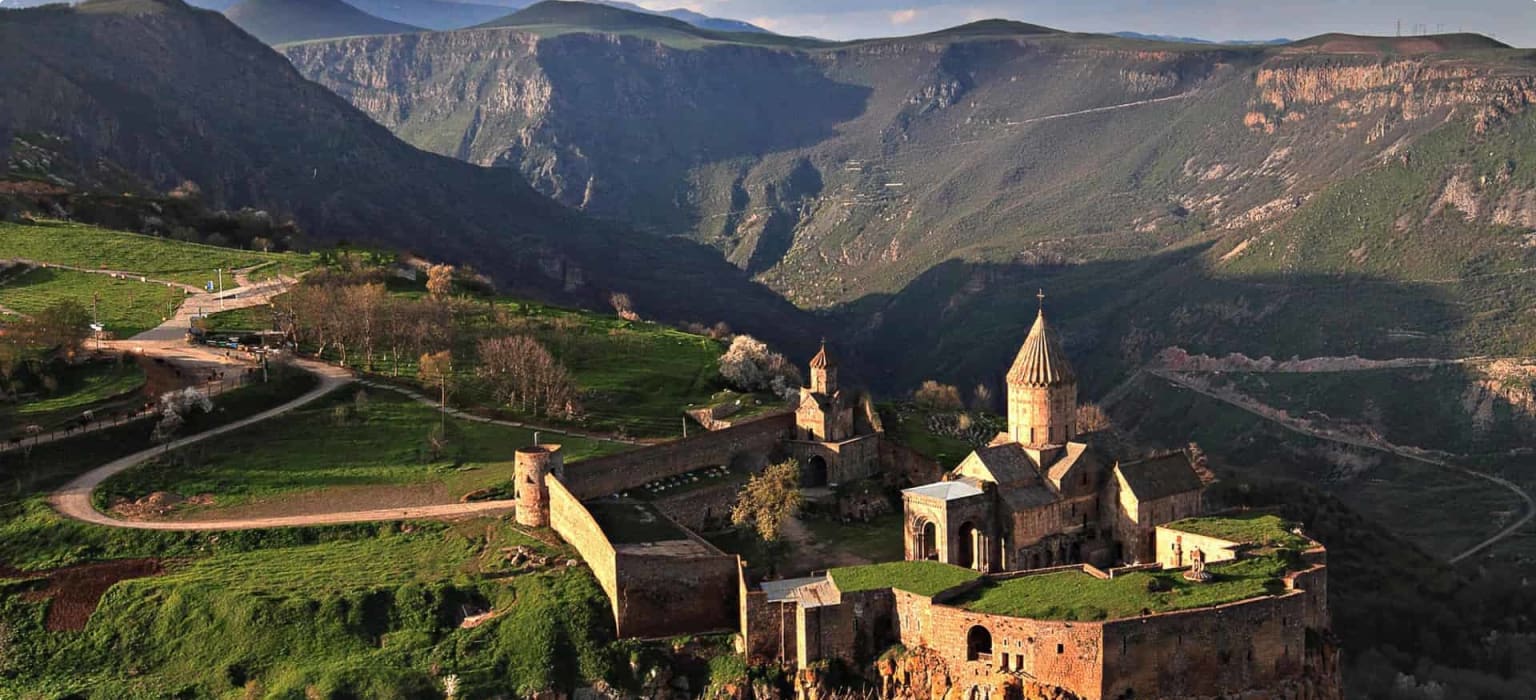
Azerbaijan
In contrast to its former invader, Iran, which is ruled by theocracy, Azerbaijan champions secularism and a separation of state and religion. It is an oil-rich country that perhaps travellers do not think to include on their list of places to visit, but Azerbaijan puts itself decidedly on the map, especially with the Azerbaijan National Aerospace Agency’s launching of its first satellite in 2013 and its recent hosting of the 2018 Formula 1 Grand Prix.
Baku is the capital, the centre of the city sitting on the shore of the Caspian Sea. Its skyline is dominated by the Flame Towers, a trio of skyscrapers that serve as the symbol of the city.
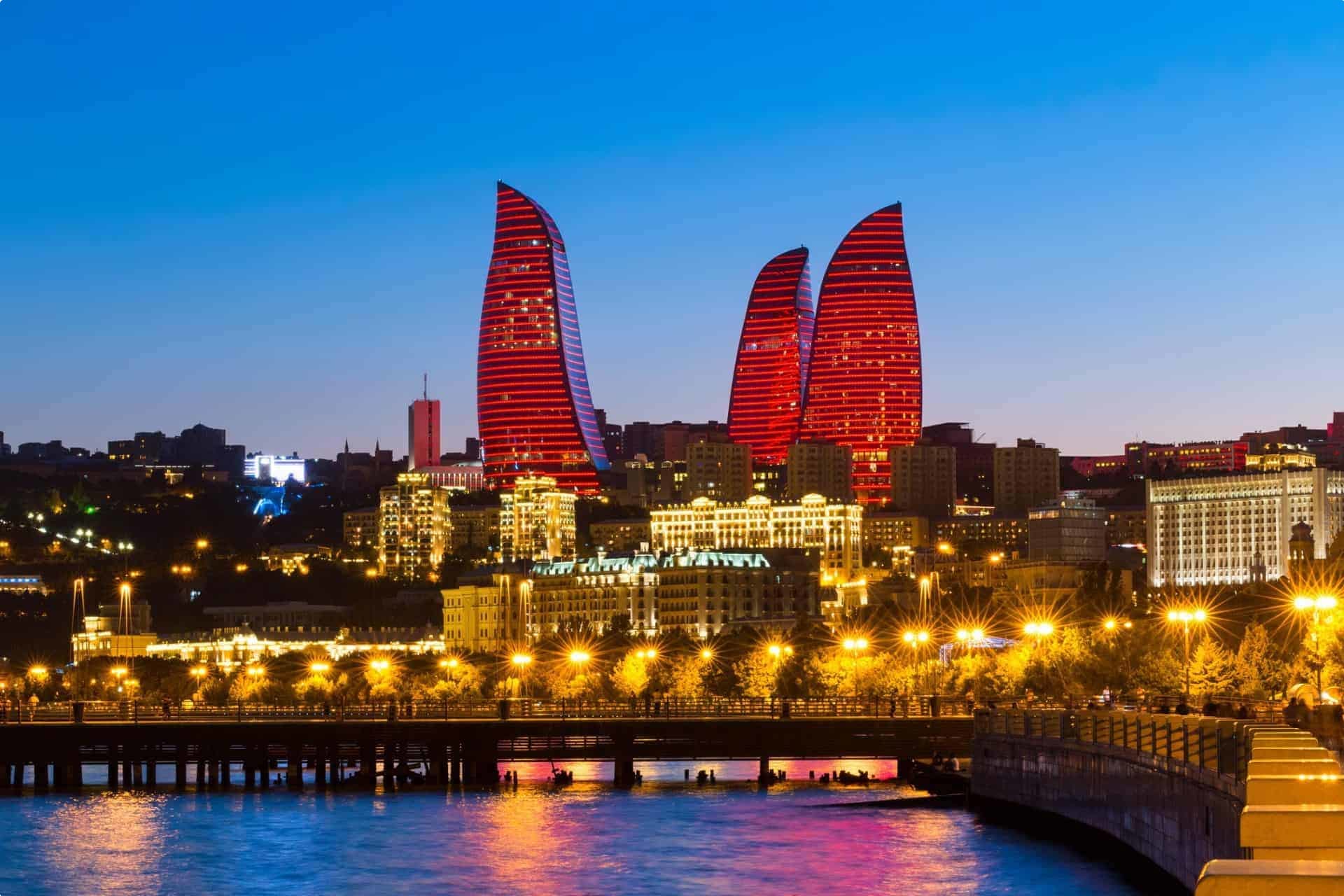
‘Azer’ in Persian means fire and the country’s nickname is ‘the Land of Fire’. Zoroastrianism, the main religion during Persian rule, puts great importance on fire, which is believed to be a source of knowledge. We now know that the country’s vast oil and natural gas reserves are responsible for the seemingly ever-burning flames that define Azerbaijan’s landscape, but during ancient times, the flames made Azerbaijan a place of great mystery and a place of pilgrimage.
Travellers can go to the Absheron Peninsula and see the pentagonal complex of Ateshgah (Fire Temple), which was built right on top of a natural gas vent. Roman records indicate that oil extraction took place on the peninsula. Unfortunately, the natural gas reserves ran out and the once eternal flame was extinguished in 1969. The flames that travellers will see today are fed by Baku’s main gas supply.
The complex is surrounded by 24 cells and rooms, built in the style of a caravanserai or roadside inn constructed for traders and travellers on the Silk Road. These rooms have been used by pilgrims, merchants, and Hindu ascetics. It fell out of use with the development of surrounding oil fields, and was turned into a museum in 1975. In 1998, it was nominated as a UNESCO World Heritage Site.

The fires on Yanar Dag (the ‘burning mountainside’), also on the Absheron Peninsula, was said to have been burning for 4,000 years and never stopped, while others put forth a more mundane explanation: the fire was accidentally ignited in the 1950s by a tossed cigarette. Whatever the origin, the burning mountainside is still a site to behold.
In the city of Baku itself, travellers should not miss the 15th century walled city of Icheri Sheher (‘inner city’), a glimpse of old Baku’s architectural grandeur. Highlights are the Palace of Shirvanshahs and the Maiden Tower, both included in the UNESCO World Heritage List of Historical Monuments. The palace complex, which also includes a bathhouse and a mausoleum, was the residence of the last rulers of autonomous Shirvan state. The purpose of the Maiden Tower was less clear; historians say it could have been a Zoroastrian fire temple, a beacon-tower, or a defence tower.

Visitors can also take a walk down the century-old Baku Boulevard, which runs parallel to the seafront.
Some 60 kilometres (37.3 miles) southwest of Baku, the Gobustan Rock Art Cultural Landscape in the semi-desert of central Azerbaijan is on the World Heritage List, and for good reason. This 537-hectare expanse of rocky boulders has more than 6,000 rock engravings representing 40,000 years of rock art, as well as cave dwellings indicating human settlement in the area dating back to the last Ice Age.
Gobustan is also home to Azerbaijan’s mud volcanoes, named as such because instead of spewing hot magma, the volcanoes spew cold mud, forced out by underground gas.
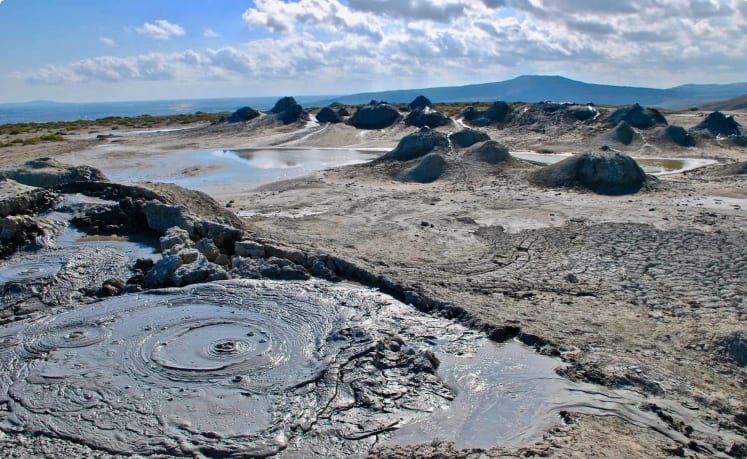
Sheki is often the last stop in an Azerbaijan tour as it sits close to Azerbaijan’s border with Georgia. Sheki was the main centre of silk production in the Caucasus, and a popular stop is the Khan’s Palace, a summer residence with intricate murals and rich colour, which UNESCO calls “a rare architectural work” (the palace is still on the Tentative List of World Heritage Sites). Walking distance from the palace is the Karavansaray Hotel, which has accommodations developed from the abandoned cavaranserai built for the Silk Road merchants.
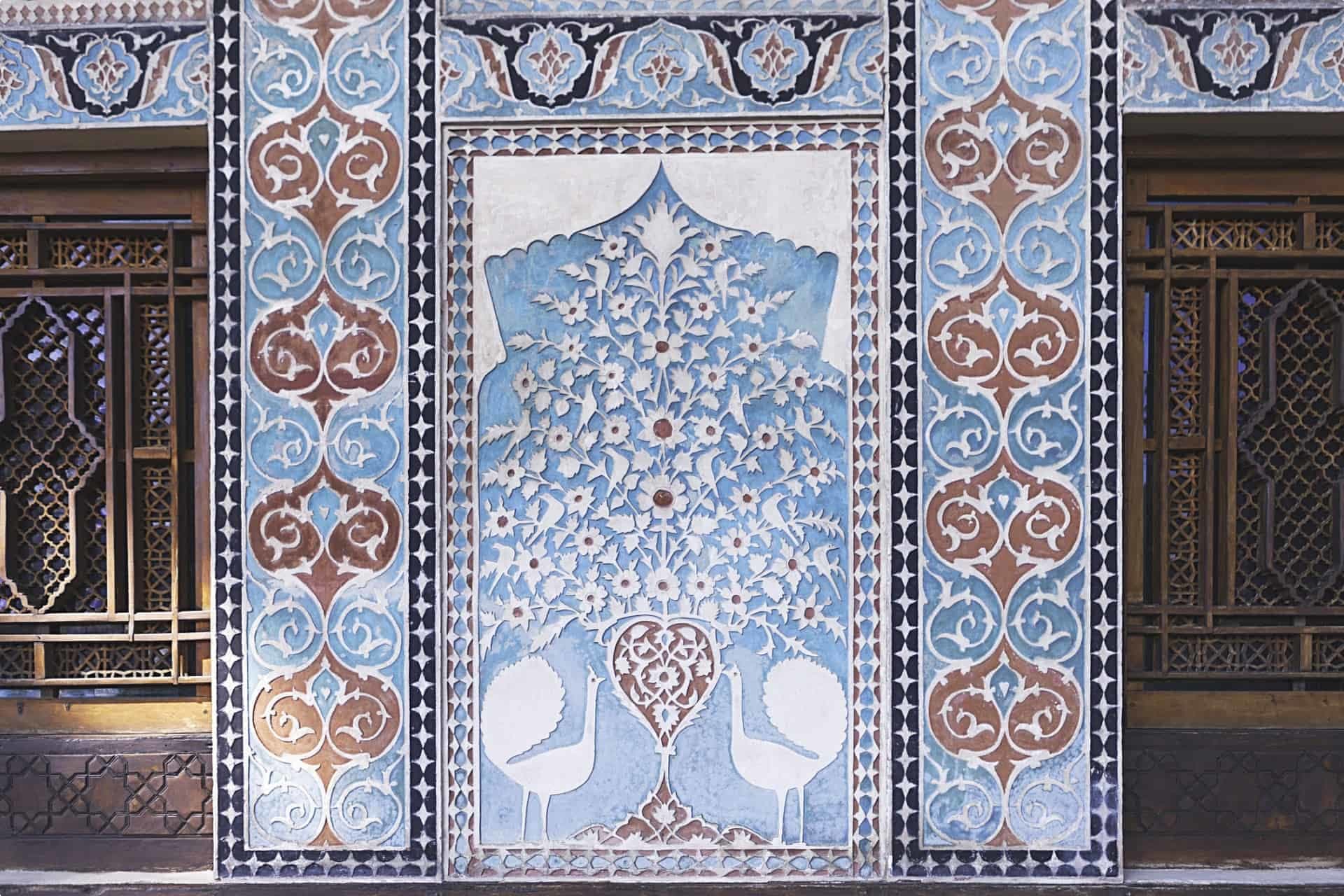
Azerbaijanis have a strong tea drinking culture dating back to ancient times, and travellers will most likely be welcomed with a cup of black tea.
Tea ceremonies have deep traditional roots in Azerbaijan. A traditional tea ceremony has its own rules and practices that are designed to make the serving and drinking process enjoyable. According to the old tradition, the host has to offer tea to every visitor, even if the visit is supposed to last only five minutes. (Source)
Cafes and restaurants abound in Azerbaijan, even within the walls of old Baku. Odyssey Travel Program Leader Dr Bruce Cameron describes an Azerbaijan tea set as “a bottomless pot of tea accompanied by a range of treats including nuts, chocolates, dried grapes and prunes, jam, and pakhlava [an Azerbaijan pastry stuffed with milled nuts and sugar]”.

Georgia
Georgia is currently enjoying a tourist boom, with 7.5 million people visiting the country in 2017, a number sure to increase as its tourism officials continue to woo travellers from Western Europe and the rest of the world. CNN hails its capital, Tbilisi, as one of seven design-savvy cities to watch in 2018. The city hosts the Mercedes-Benz Fashion Week, and in November 2017 American filmmaker David Lynch visited on behalf of his foundation, which plans to open a cinema institute in the city.
Georgia is opening up to the world and to the future, but travellers are still attracted to its rich past. The city’s heritage sites are clustered in Old Tbilisi, which is also famous for its sulphur bathhouses, a perfect stop during the colder months of October to March. The city itself (Tbilisi means ‘warm place’) was built around these natural thermal springs, which were believed to have healing properties. Travellers are enticed to have a soak and cure skin problems, joint pains, and other ailments.
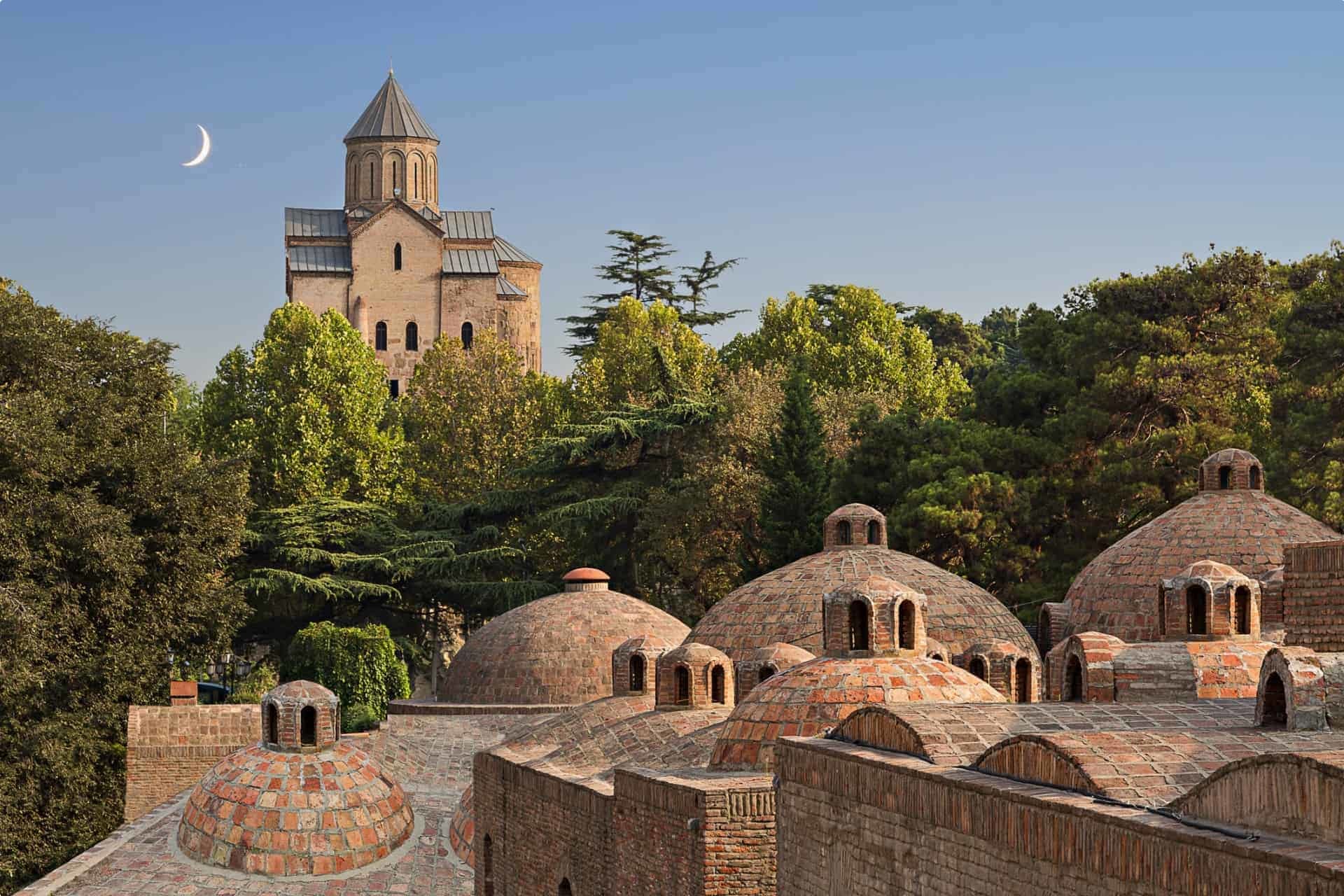
The Narikala Fortress, dating back to the 4th century, sits on a steep hill and can be seen from any point of Old Tbilisi. Travellers who are able can climb to the top and view the city from the ancient battlements. The fortress stood as a witness to the city’s beginnings and had been expanded by Georgia’s invaders, the Arabs (circa 7th century) and the Mongols (circa 11th century). The lower part of the fortress has the St. Nicholas Church which dates back to the 12th century.

Anchiskhati Basilica is the oldest surviving church in Tbilisi and one of its most beautiful. It dates back to the sixth century and its design differs from the architecture seen in later temples. There are some breathtaking frescoes to be seen inside the church, some dating back almost 400 years.
Walk down Rustaveli Avenue, Tbilisi’s main thoroughfare, named after the Georgian poet, Shota Rustaveli. Several important buildings flank the avenue, including the former Parliament building of Georgia, the Georgian National Opera Theatre, the Rustaveli State Academic Theatre, the Georgian Academy of Sciences, and Kashveti Church. Also on the avenue is the Museum of Georgia, which contains an impressive collection of pre-Christian artefacts dating back to the 3rd millennium BC, including gold from the ancient kingdom of Colchis.
The Gelati Monastery commissioned by Georgia’s great king David the Builder offers a glimpse of the grandeur of Georgia’s golden age. It is inscribed on the World Heritage List. According to UNESCO, the main church of the monastic complex ‘is the only medieval monument in the larger historic region of Eastern Asia Minor and the Caucasus that still has well-preserved mosaic decoration, comparable with the best Byzantine mosaics, as well as having the largest ensemble of paintings of the middle Byzantine, late Byzantine, and post-Byzantine periods in Georgia, including more than 40 portraits of kings, queens, and high clerics and the earliest depiction of the seven Ecumenical Councils.’
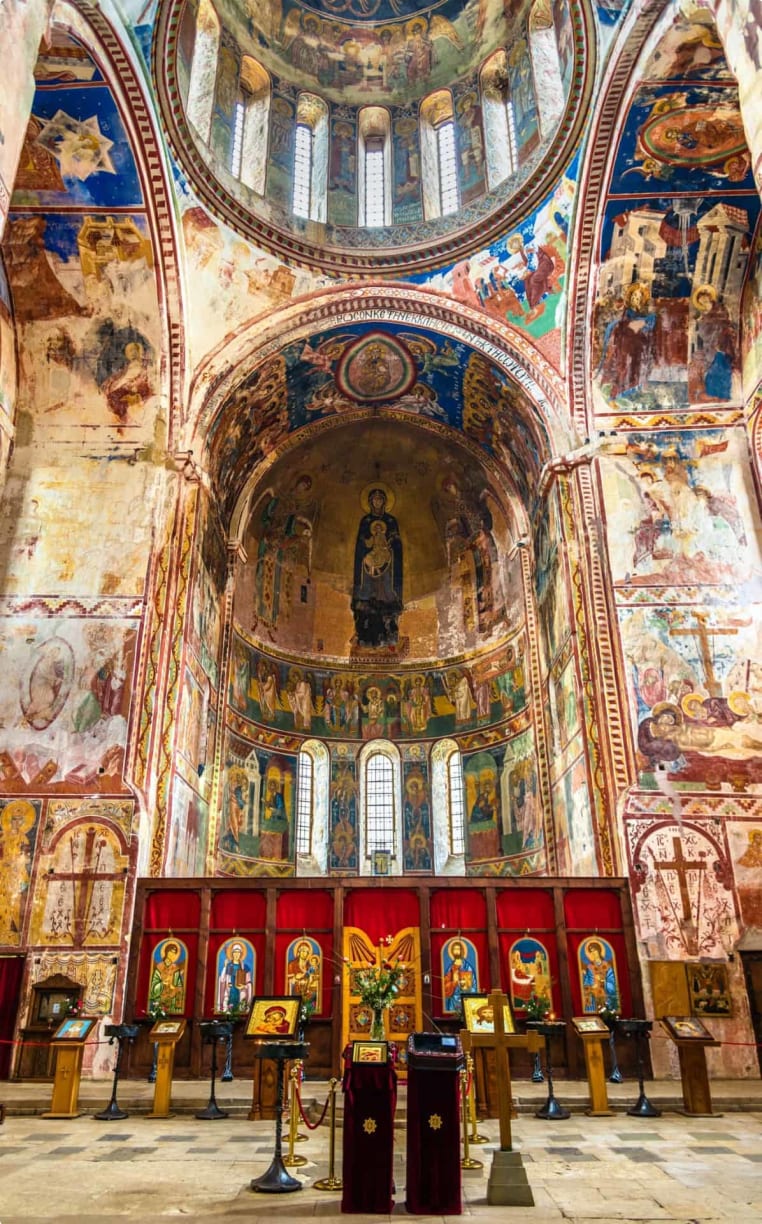
David the Builder envisioned Gelati to be a centre of science and education. In addition to the monastery, he also established an academy that gathered philosophers and other intellectuals, as well as a scriptorium where monastic scribes copied manuscripts, including a 12th century gospel that is now housed in the National Centre of Manuscripts.
Mestia is also a highlight for travellers. The main regional centre of Upper Svaneti, Mestia is located about 500 km from Tbilisi and sits around 1700 above sea level. This is often the starting point for travellers who want to explore Svaneti and go further up to the glaciers of Mt. Ushba. Visitors can also go skiing in the many elegant ski resorts in the region. Skiing is also a possibility in Georgia’ east. Gudauri Ski Resort in the Stepantsminda District is the biggest in Georgia and offers a great opportunity to see true mountain wilderness.

On the coast of the Black Sea sits the seaside town of Batumi. Travellers can take a walk down Batumi Boulevard, which dates back to 1881. The boulevard has a park with modern sculptures, beach bars, cafes, and restaurants. Here stands the Batumi Ferris Wheel, as well as the Alphabet Tower, a 145m-high monument to Georgian script and culture and Batumi Tower, which, at 200 metres, is Georgia’s tallest building. The facade of the Batumi Tower features its own miniature Ferris wheel.
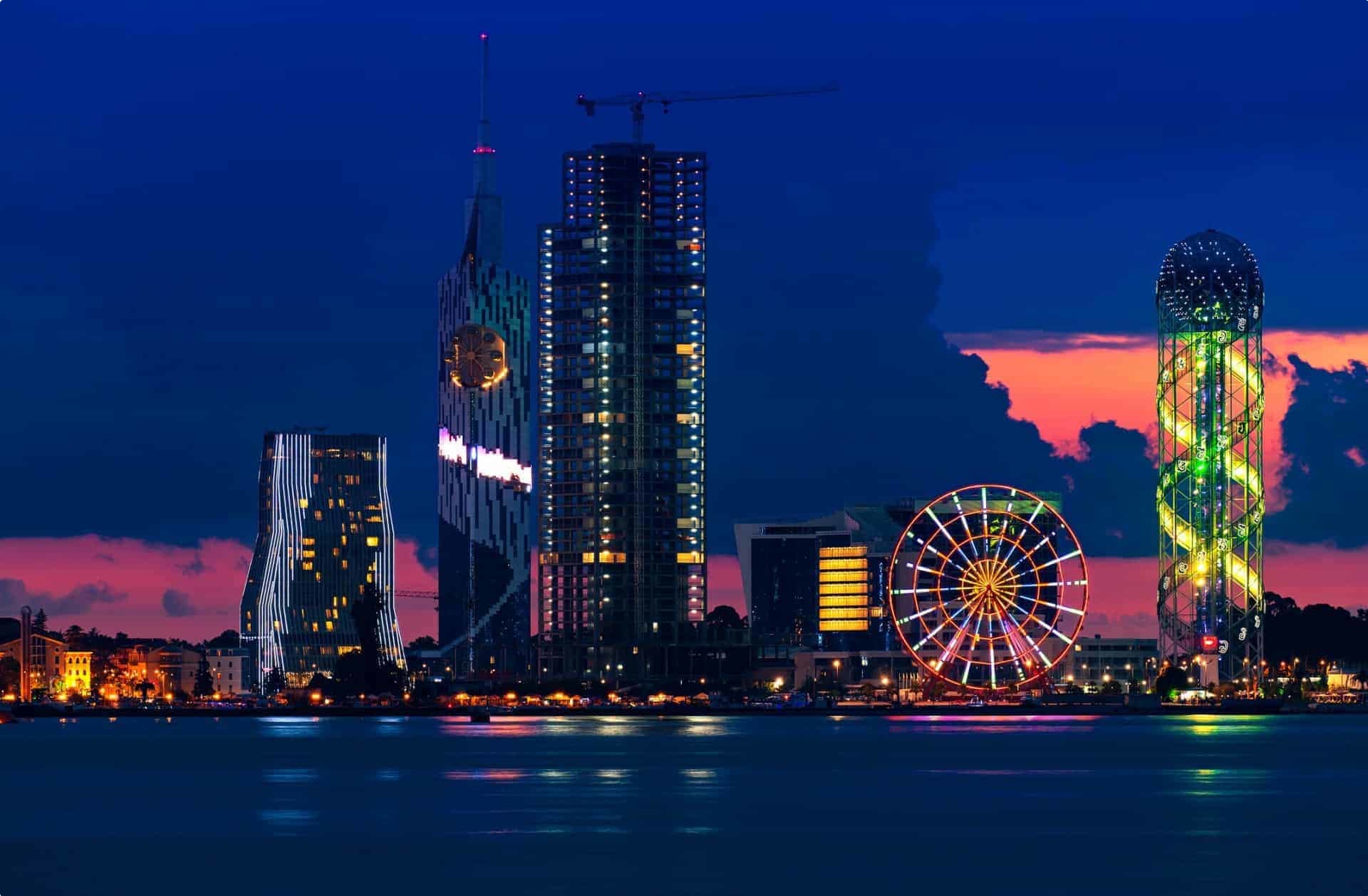
Georgia’s Kakheti region is famous for its vineyards, and travellers can join wine tasting tours to learn more about a wine-making tradition that dates as far back as 8,000 years ago, while also sampling Georgian wines. Georgians still use the traditional Qvevri method, where grapes are pressed and transferred to large egg-shaped earthenware pots (called the qvevri), which are then sealed and buried underground to ferment for up to six months. This traditional method of wine-making is passed down through the generations. In 2013, it was inscribed on the UNESCO Representative List of the Intangible Cultural Heritage of Humanity.
For something completely different but just as thought-provoking, travellers may trace the ‘ugly walk’ tour in Tbilisi, organised by the group Iare Pekhit in an effort to show how unplanned urban development spurred by corrupt government deals and privatisation of private land negatively affects Georgia’s citizens, heritage, and environment. This November 2018 Guardian article by Oliver Wainwright points out the architectural projects of Georgia’s former president Mikheil Saakashvili (who was President from 2004 to 2013 and faces criminal charges): the public service hall, the Bridge of Peace, and the unfinished concert hall and exhibition centre.
Travellers should not miss Georgian cuisine, unique to the region but also influenced by Eastern Europe, the Middle East, and its neighbouring countries in the Caucasus. Bread is a staple in Georgian dishes. Khinkali or Georgian dumplings is a traditional dish made of twisted dough stuffed with meat and spices, and Khachapuri or Georgian Cheese Bread is cheese-stuffed bread but can also be egg-topped like the variant Adjarian khachapuri.

Armenia
Similar to its neighbouring countries in the South Caucasus, Armenia has a history marked by incredible losses and bloody wars, which continued even after its independence from the former Soviet Union. But the tide seems to have turned in 2018. Armenians, led by opposition politician Nikol Pashinyan, joined a series of peaceful anti-government protests from April to May 2018. The protests were in response to Pashinyan losing his bid for the Prime Minister seat, and Serzh Sargsyan being elected for his third consecutive term as head of state. Dubbed the Armenian ‘Velvet Revolution’, it led to Sargsyan’s resignation, Pashinyan being named Prime Minister, and Armenians expressing hope for a better future.
Armenia’s tourism industry has also been flourishing. A big draw is the capital, Yerevan, 23 kilometres (14 miles) from the Turkish border. The city skyline offers a beautiful view of Mt. Ararat (in Turkish territory) in the south. The 2,800-year-old city experienced tremendous growth due to industrialisation, growing from a town of 30,000 people in 1914 to a booming urban centre of more than a million in the latest census.
Most buildings are designed with a pink volcanic stone called tuff, making the city’s scenery glow pink at dusk (as can be seen in this photo).
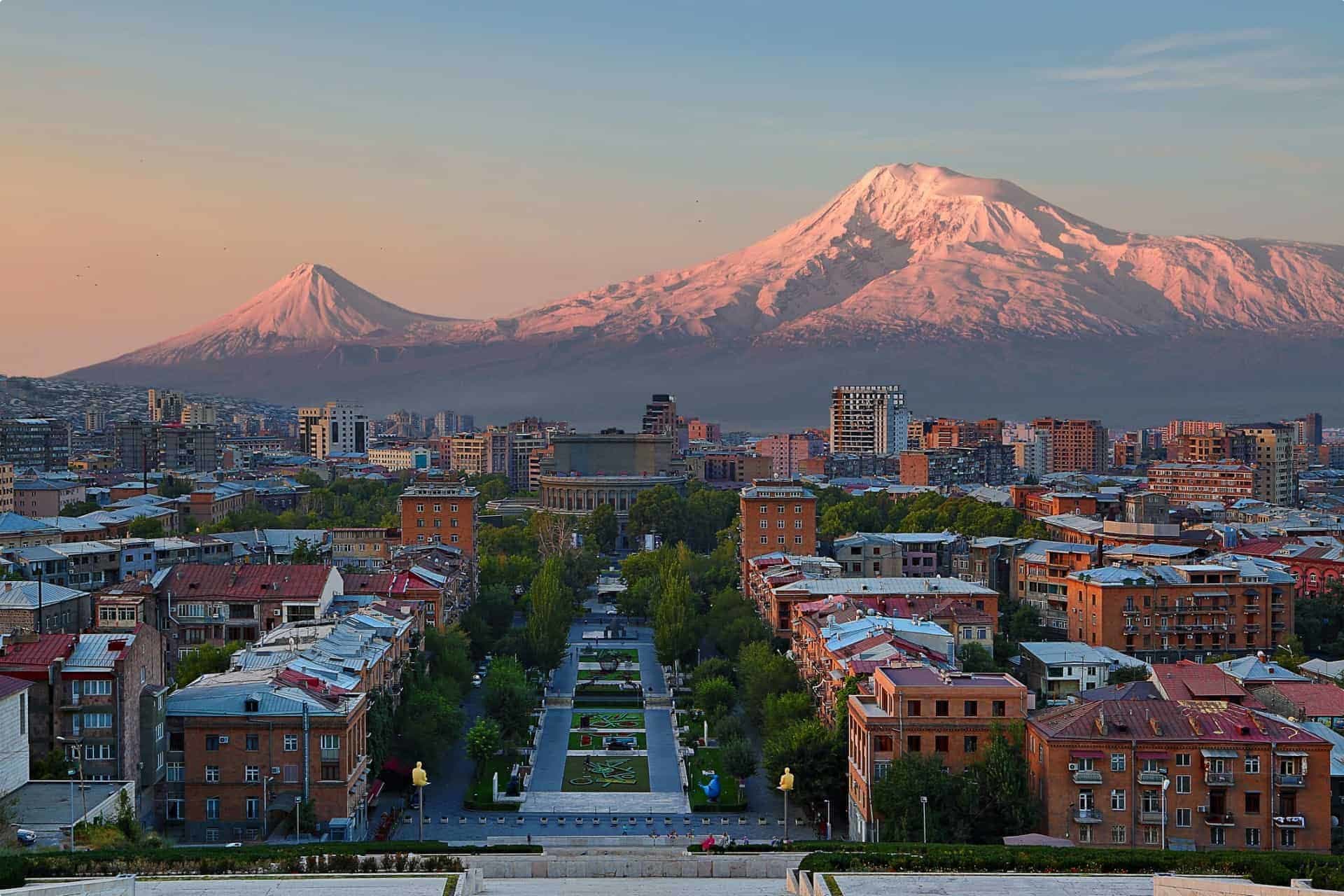
Completed in 1967, the Tsitsernakaberd Memorial Complex or the Memorial Complex to Genocide Victims in Yerevan is dedicated to the memory of the Armenians who perished in the Armenian Genocide. The Memorial is composed of a partly split 44-meter arrow-shaped slab of granite, symbolising the Armenian diaspora and unity, and 12 leaning basalt slabs reminiscent of the traditional khachkars, surrounding an eternal flame as though in mourning. Khachkars, also known as the Armenian cross-stones, are carved memorial stone slabs bearing a cross and other intricate detail such as rosettes or carvings of animals.
Yerevan’s Republic Square, the city’s focal point renowned for its musical fountains, was designed by architect Alexander Tamanyan in 1924 and originally named after Vladimir Lenin until 1991. Today, it is described as one of the finest central squares created anywhere in the world during the 20th century and is an important civic space for the Armenian people.

Outside Yerevan, travellers visit Lake Sevan, the largest body of water in Armenia and the Caucasus region. This gorgeous freshwater lake is located in Gegharkunik Province, which is twice as high in elevation as Yerevan, a perfect sanctuary from the summer heat. Remnants of the 9th Century Sevan Monastery (Sevanavank) sit on a peninsula that was once an island in this lake. The island transformed into a peninsula following the lake’s artificial draining under Joseph Stalin.
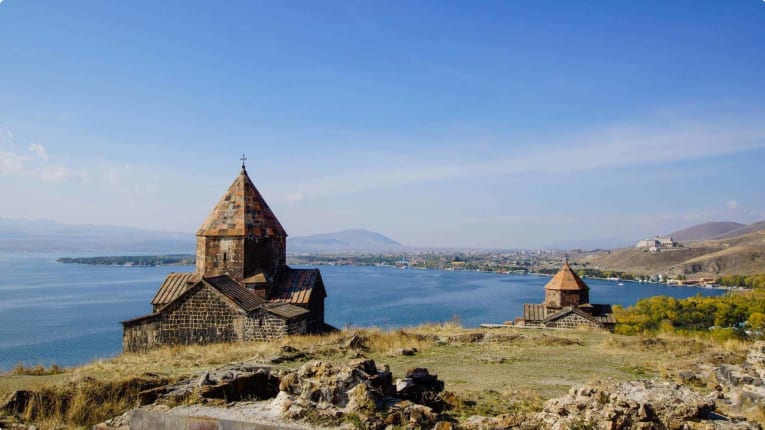
The medieval Noratus Cemetery contains the largest cluster of khachkars in Armenia. Each of the 50,000 khachkar in Armenia has its own pattern; no two are alike. The symbolism and craftmanship of the khachkars have been inscribed in the UNESCO list of Intangible Cultural Heritage of Humanity since 2010.
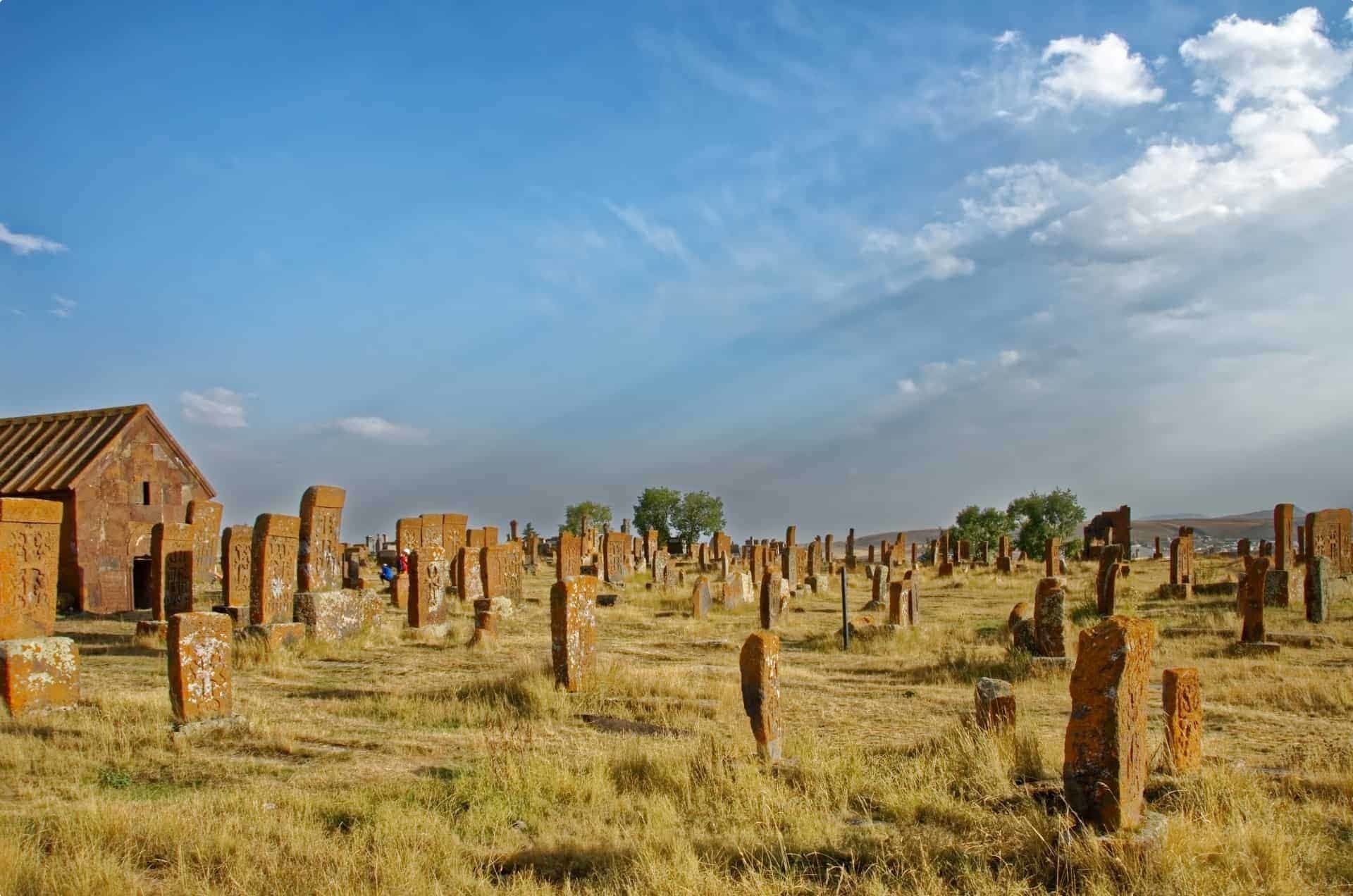
Khor Virap Monastery (‘khor virap’ is Armenian for ‘deep dungeon’) is located on a small hill surrounded by green lands and vineyards, with the stunning Mount Ararat as its backdrop. Originally a prison site, Khor Virap was where Grigor Lusavorich, later Saint Gregory the Illuminator, was held for 13 years, imprisoned by the Arsacid King Tiridates III for preaching Christianity. He survived his ordeal and later became the king’s religious mentor, converting him—and therefore Armenia—to Christianity. A chapel was built in 642 AD and Khor Virap became an important pilgrimage site. Regular church services are still held here and the view of Mount Ararat is not to be missed.
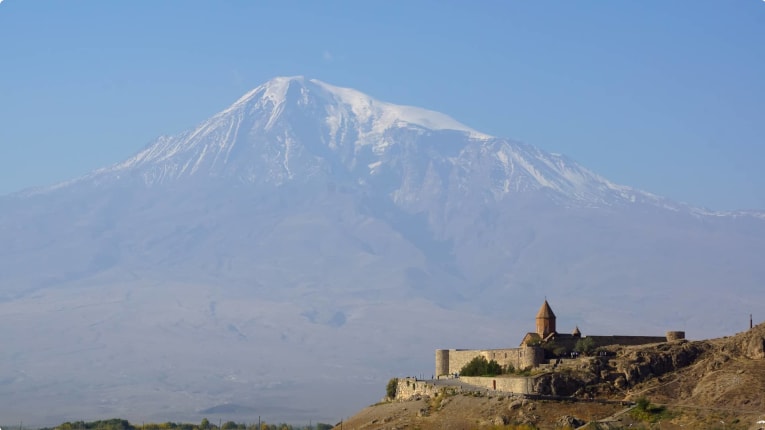
The Echmiadzin Cathedral, built in the early fourth century over a pagan temple, is considered the oldest cathedral in the world. It is the holy seat of the Catholicos of All Armenians, the spiritual leader of the Armenian Apostolic Church. As the earliest known domed church, the cathedral’s architecture exerted profound influence on Christian architecture. The church’s exterior features carved reliefs and ornaments, and the interior showcases a painted dome and frescoes depicting scenes from the Old Testament. It is listed as a UNESCO World Heritage Site.
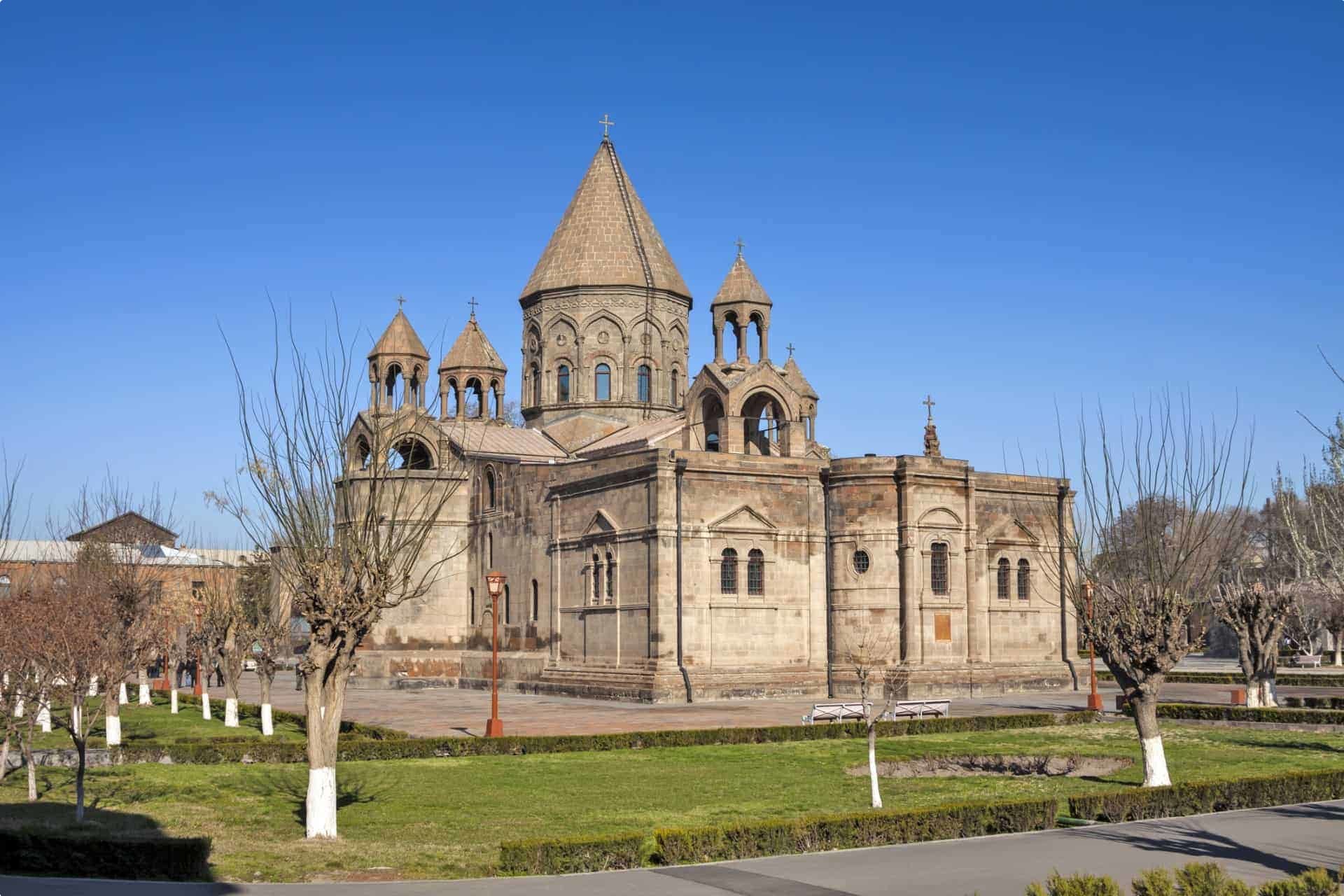

Another Armenian World Heritage Site is the medieval monastery Geghard, which dates back to the fourth century. This collection of churches and tombs is an architectural marvel as the complex is partially carved out of the rock of a mountain, and surrounded by cliffs and a defensive wall. It houses a number of religious relics, including the spear that was said to have wounded Christ on the cross. In fact, the monastery’s present name comes from this celebrated relic: Geghardavank (‘the Monastery of the Spear’), a name first recorded in the 12th century.
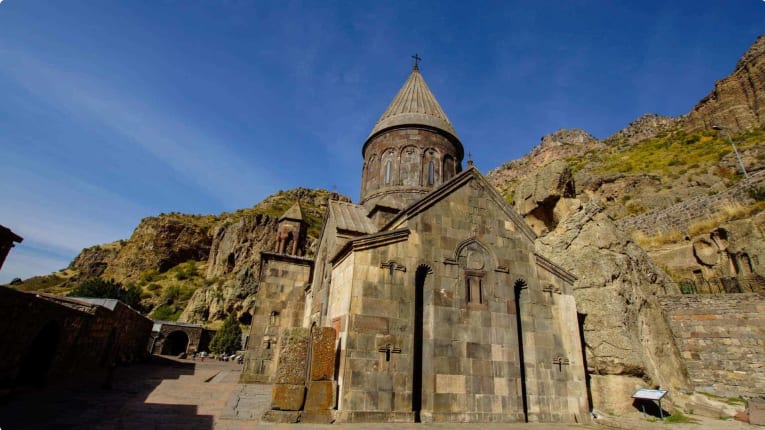
An architectural and religious puzzle, the Temple of Garni is a Greco-Roman temple in Armenia which would have looked more at home in Rome or Athens, thousands of miles away. It is the only pre-Christian building still standing in Armenia today, a mystery in itself as Tiridates III’s regime destroyed all other pagan temples upon Armenia’s adoption of Christianity. The temple was said to have been built by Tiridates I in the first century, dedicating it to the Zoroastrian goddess Mythra, which was adopted by the Romans as a sun goddess. What visitors see today is a reconstruction of the original temple, which was destroyed in a 17th century earthquake.
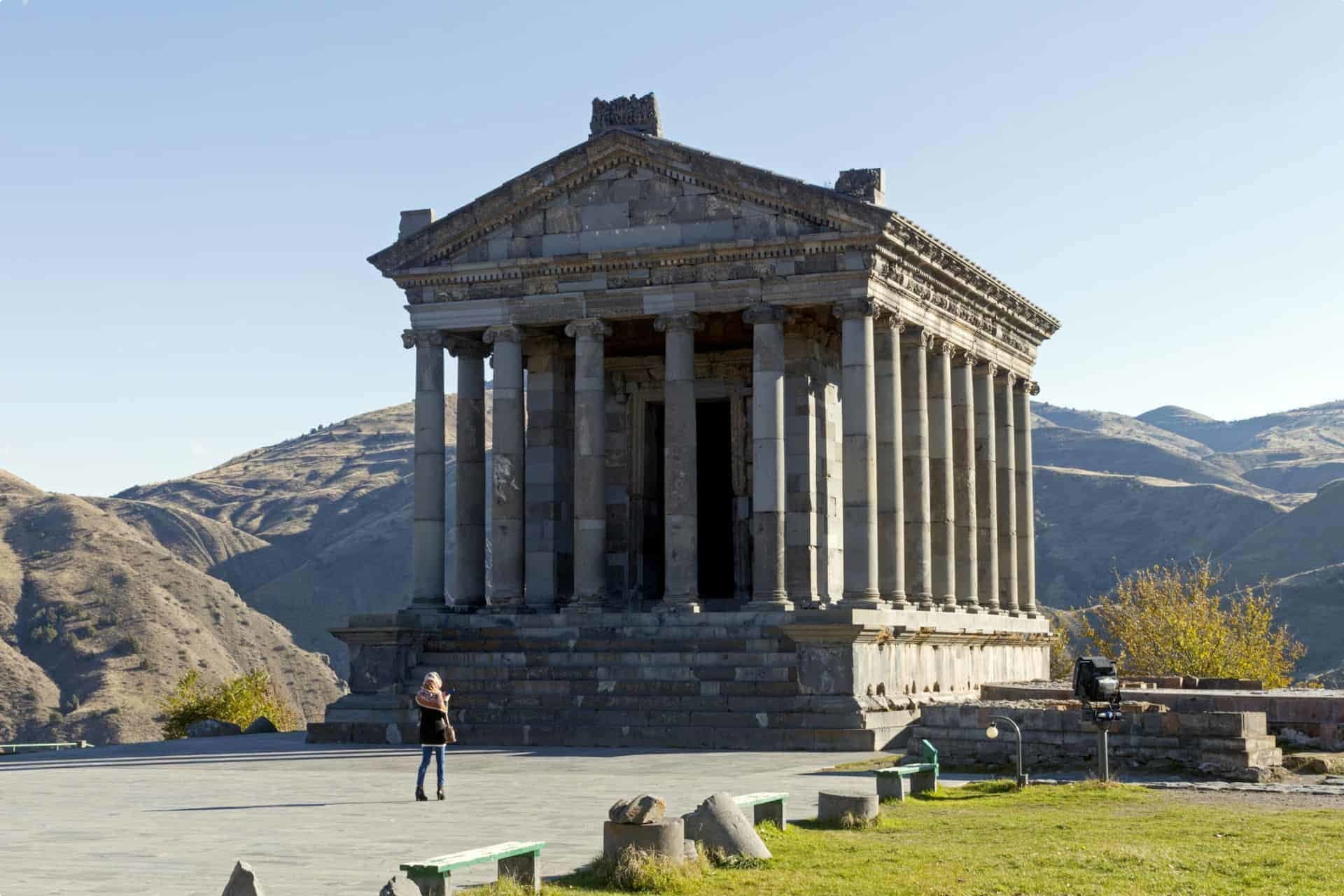
Survivors of the Armenian genocide formed a vast, global diaspora, mixing their food traditions with the traditions of their new countries. This means ‘Armenian food’ outside of Armenia may be different from what is served in Armenian homes. Village homes often have an oven called a tonir where tonir lavash (flatbread) and a sweet bread called gata are made. Pork barbecue (called khorovat, or shish kebab in the diaspora) are cooked suspended over coals. Manti is a traditional Armenian dish consisting of a spiced meat mixture wrapped in dough and served with yogurt.

If you want to learn more about Armenia, Azerbaijan, and Georgia, join Odyssey Traveller’s escorted small-group tour to the Caucasus. Click through to read the itinerary or sign up!
Related Tours
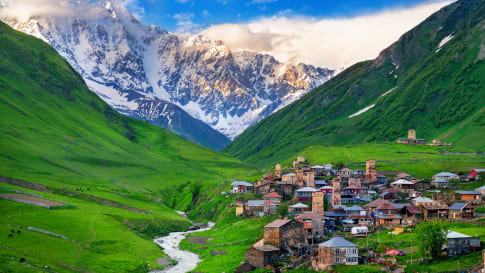
22 days
May, OctSmall Group Tour to the Caucasus | Armenia Azerbaijan Georgia
Visiting Armenia, Azerbaijan
This small group program is designed to give people an opportunity to explore Tbilisi, Baku, Yerevan as well as important monuments, historical and religious sites, diverse landscapes and ancient architecture by visiting the Caucasus Mountains and the lowlands of Armenia, Georgia and Azerbaijan. Led by local English speaking guides, there will be the opportunity to meet local people.
From A$12,425 AUD
View Tour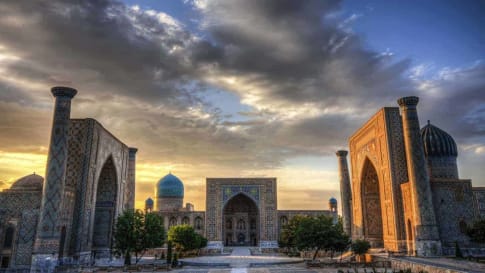
31 days
May, AugTravel on the Silk Road of Central Asia | Small Group Tour for Seniors
Visiting Kazakhstan, Kyrgyzstan
The Silk Road is an ancient trade route linking China and Imperial Rome through Central Asia. Few areas in the world remain as unexplored or offer such richness in terms of ancient and modern history, culture, and scenic diversity as Central Asia. Our Small group Silk road tours itinerary explores the Road through remote deserts and mountainous environments as we visit key sites between Almaty and through to Samarkand over 31 days.
From A$22,985 AUD
View Tour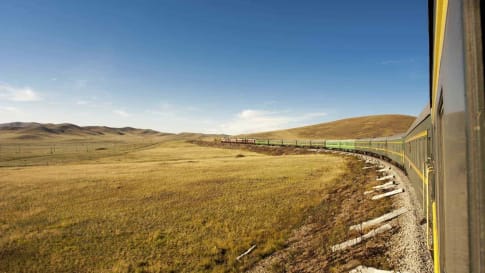
days
JulJourney through Mongolia and Russia small group tour
Visiting Mongolia, Russia
This escorted small group tour traverses this expanse, from Ulaanbaatar to St Petersburg; from the Mongolian Steppes to Siberian taiga and tundra; over the Ural Mountains that divide Asia and Europe to the waterways of Golden Ring. Our program for couples and solo travellers uses two of the great rail journeys of the world; the Trans Mongolian Express and the Trans Siberian Express.
From A$17,850 AUD
View Tour



